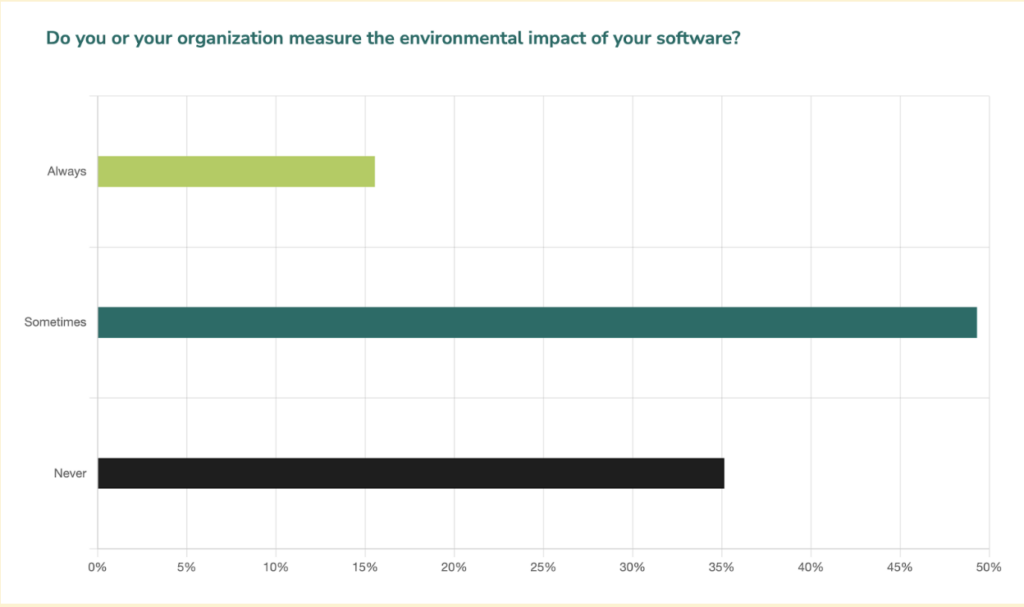Table of Contents
Software developers and other ICT stakeholders are actively contributing to climate goals. According to the SOGS survey, 15.6% of over 2,000 software practitioners work for organizations that consistently measure the carbon impact of their software, while 49.3% report that their organizations occasionally assess the carbon impact. Companies and other organizations need green software tools to reduce, measure, and report their scope. BCG’s 2022 report on AI for the Planet states that AI can help with measuring and reporting carbon emissions.

“What gets measured, gets managed.” ~ Peter Drucker
A significant number of software practitioners are taking proactive measures to reduce the carbon footprint of their software, with 11.5% indicating they consistently engage in such efforts and 44.8% stating they do so occasionally. Regarding the methods employed to decarbonize software, 24.7% focus on creating energy-efficient software, 20.93% emphasize developing software compatible with older hardware or devices, 35.2% prioritize maximizing hardware utilization, and 44.6% underscore minimizing the volume of data their software transmits and receives.
Selection of Green Software Tools That Make an Impact
- Website Carbon Calculator
Introducing the inaugural methodology for calculating carbon emissions linked to a website, and this complimentary website carbon calculator aims to raise awareness and inspire a more sustainable internet.
- Customer Carbon Footprint Tool
One of the green software tools that allows you to monitor, quantify, assess, and predict the carbon emissions stemming from your utilization of AWS.
- Emissions Impact Dashboard
Calculate your carbon emissions, including those you’ve already saved, in connection with the utilization of Microsoft Azure and Microsoft 365 cloud services. Use this information to make informed decisions and create new efficiencies in your cloud usage. - Cloud Carbon Footprint
Free and Open Source Cloud Carbon Emissions Measurement and Analysis Tool that helps to discover the carbon footprint of your cloud usage, take steps to reduce it, gain insights into how your cloud usage affects the environment, and learn actionable measures to address it.
- Code Carbon
Monitor and minimize CO2 emissions from your computational activities. While AI can bring various societal benefits, the energy demands of AI computing can impose a significant environmental cost. CodeCarbon, a lightweight software package seamlessly integrated into your Python codebase, calculates the carbon dioxide (CO2) emissions generated by the cloud or personal computing resources executing the code. It provides developers with insights on reducing emissions by optimizing code or choosing cloud infrastructure hosting locations with a reliance on renewable energy sources. - The Green Metrics Tool
It is a green software tool intended for assessing the energy and CO2 consumption of software by employing a software life cycle analysis (SLCA). The design emphasizes the reuse of existing infrastructure and testing files to facilitate seamless integration into any software repository, fostering transparency regarding software energy consumption. - Green Cost Explorer
Conducting an analysis of climate-related expenses on AWS involves leveraging Amazon’s breakdown of regions utilizing sustainable power and those that do not. By utilizing the cost-explorer tool in conjunction with this information, you can gain insights into areas where you may inadvertently be allocating funds toward fossil fuels.
- Carbon Footprint
Quantify, report, and mitigate your cloud carbon emissions. This tool enables you to incorporate comprehensive carbon emissions data into reports and disclosures, visualize carbon insights through dashboards and charts, and decrease the overall emissions of cloud applications and infrastructure. - Kube Green
How often do your development or preview pods remain active over the weekends or during the night? It’s a needless drain on resources and finances! Enter kube-green – a straightforward Kubernetes addon that autonomously powers down (selected) resources when they are not in use.
- Carbon Tracker
Carbontracker is a green software tool designed to monitor and forecast the energy consumption and carbon footprint of training deep learning models. - JoularJX
JoularJX is a Java-based agent developed for monitoring software power at the source code level. - Kepler
Kepler (Kubernetes Efficient Power Level Exporter) employs eBPF to probe energy-related system statistics and exports them as Prometheus metrics. - EcoCode
The EcoCode Android SonarQube plugin is a static code analyzer designed for “eco-responsibility” in native Android projects written in Java (Kotlin is not supported at this time). Its purpose is to identify code smells, indicating areas in the source code that can be enhanced to minimize environmental and social impact. - Ec0lint
ec0lint is a static code analysis tool that offers users guidance on minimizing the carbon footprint of their websites during the development phase. Implementing code adjustments recommended by ec0lint leads to reduced carbon emissions per visit, faster loading times, and improved space efficiency. The community drives this open-source tool.
- Fruggr
Before setting goals and determining the route to achieve them, it’s essential to understand your starting point. Progress requires measurement! Fruggr is one of the green software tools that aid in enhancing the environmental and social footprint of IT. It provides a comprehensive, tailored, and automated solution to develop your decarbonization strategy. - GreenDroid
An Android application tool designed to identify energy leaks, GreenDroid helps pinpoint methods within an application that are most likely linked to abnormal energy consumption. This is achieved by executing a series of tests (standard Android tests, developed using the Android test framework) and gathering information about the invoked methods, the time spent on each test, and an estimate of the energy consumed per test.
- GreenHub
A cooperative method for analyzing power consumption in Android devices. - GSF Green Maturity Matrix for Tech
A self-assessment tool for organizations in green technology. It aids organizations in gauging the extent to which they have incorporated green principles, patterns, and processes into the construction and operation of their software systems.

The significance of employing green software tools lies in their ability to contribute to environmental sustainability and reduce the ecological footprint of digital technologies. Green software tools prioritize energy efficiency, minimize resource consumption, and promote green practices in software development and usage. By adopting these green software tools, organizations and individuals can play a crucial role in mitigating the environmental impact of the software industry, fostering a more sustainable and responsible approach to technology. The use of green software tools aligns with broader efforts to address climate change and promotes a greener, more environmentally conscious digital landscape.
Should you be considering the development of green software tools or have a green software project in mind, please inform us! We are eager to learn more about it and actively contribute in any way we can. We hope you find these green software tools helpful.
Author
-
Ekaterina Novoseltseva is an experienced CMO and Board Director. Professor in prestigious Business Schools in Barcelona. Teaching about digital business design. Right now Ekaterina is a CMO at Apiumhub - software development hub based in Barcelona and organiser of Global Software Architecture Summit. Ekaterina is proud of having done software projects for companies like Tous, Inditex, Mango, Etnia, Adidas and many others. Ekaterina was taking active part in the Apiumhub office opening in Paseo de Gracia and in helping companies like Bitpanda open their tech hubs in Barcelona.
View all posts









